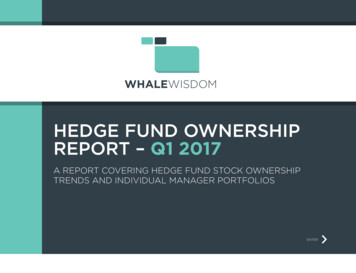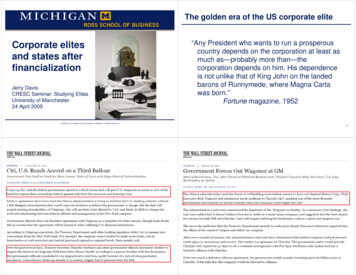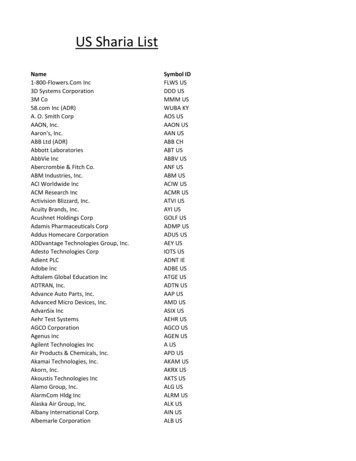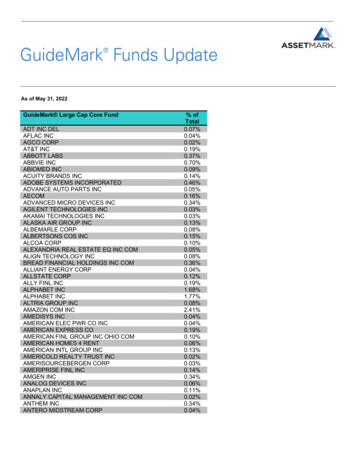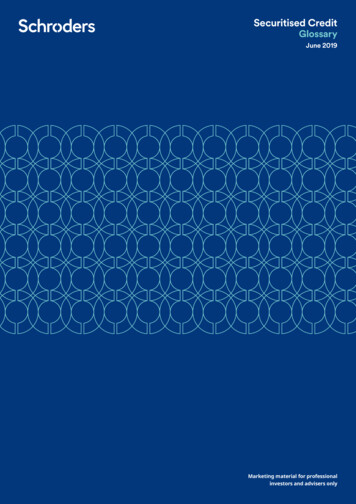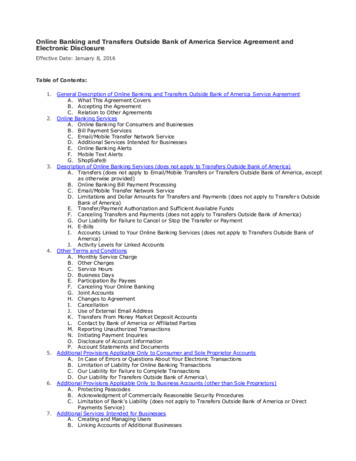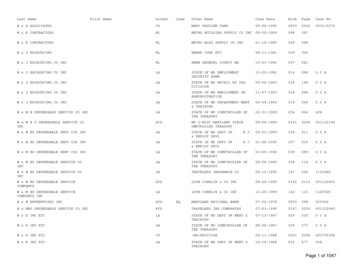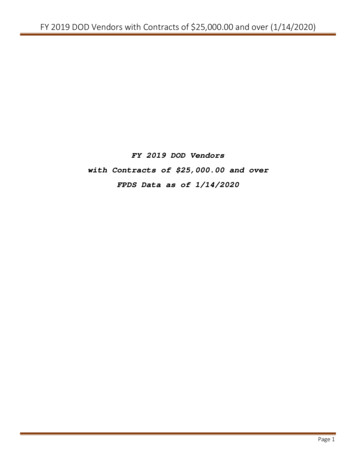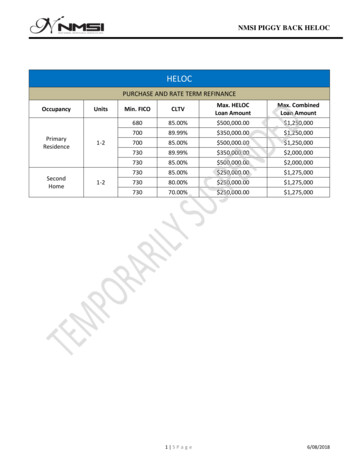
Transcription
NMSI PIGGY BACK HELOCHELOCPURCHASE AND RATE TERM -21-2Min. FICOCLTVMax. HELOCLoan AmountMax. CombinedLoan Amount68085.00% 500,000.00 1,250,00070089.99% 350,000.00 1,250,00070085.00% 500,000.00 1,250,00073089.99% 350,000.00 2,000,00073085.00% 500,000.00 2,000,00073085.00% 250,000.00 1,275,00073080.00% 250,000.00 1,275,00073070.00% 250,000.00 1,275,0001 5P a g e6/08/2018
NMSI PIGGY BACK HELOCAppraisal RequirementsBankruptcyBorrower Eligibility Credit Eligible Property TypesCondos Escrow Holdbacks Foreclosure, Modification,or Short SaleFloor Rate Qualifying Rate ARM Income Appraisals are good for 120 days.Re-certification of value NOT allowedNO PIW (Property Inspection Waiver) are acceptable.The property should be 10 acres or less.No bankruptcy filing within the last 8 yearResident Alien: Allowed, Resident card & Green card requiredNon-permanent resident: Allowed, Visa & Passport & I-94/I-797 or EAD cardrequiredNon-occupant co-borrower: NOT AllowedMinimum of 3 trade lines (open or closed) combined between all borrowers,with 1 trade line originated at least 3 years prior to the Credit Bureau date.Collection/Judgement and Liens must be paid off.Disputed Act must have proof of resolutionSFR/PUD, Condos, Townhouse, 1-2 unitsA property with the valuation done on an Individual Condominium UnitAppraisal Report (FNMA 1073).A property defined as a condominium by the Title Commitment.A property with stacked units.Owner occupancy percentages;- Existing projects: 51% O/O- New construction projects: 70% O/O based upon pre-sale/sold/settled.NMSI will accept appraisals that contain cost to cure items/adjustment subjectto the following requirements:- Cost to cure is 1% or less of the appraised value – No additional review orapproval is required and the repairs do not need to be completed.- Cost to cure is between 1% and 3% of the appraised value: NMSI willreview the appraisal and determine if the cost to cure is related to safetyand/or livability issues (i.e. exposed electrical wires, mold, or damagedroof). If the cost to cure is determined to be a safety and/or livability issue,approval must be obtained from the OUPA, which will determine if therepairs need to be completed prior to approval. If the cost to cure is not asafety and/or livability issue, the UA Department may approve theappraisal and the repairs do not need to be completed.Cost to cure is higher than 3% of the appraised value: The repairs must becompleted prior to approvalNo foreclosure, deed-in-lieu of foreclosure, short sale or "real estate accountpaid for less than full balance" within the last 5 years.Floor rate of 51 bps below the initial rate or 4.99%, whichever is greater,unless the initial start rate is less than 4.99%, then the floor rate will be equalto the initial start rate.Typically 2% above the start rate.Self-Employed When comparing the two-year period, if the most recent year is higherthan the previous year, a true average is taken.2 5P a g e6/08/2018
NMSI PIGGY BACK HELOC If the most recent year is less than the previous year, the income isanalyzed to see the percentage of change. If the decrease is more than20%, the lower income is used.- If DU/LP only asks for one year taxes for s/e borrower, we are able to go thisroute. However, if the borrower also receives W-2’s, we will need two years onthis income. Using YTD paystub and last year’s w-2 in addition to the taxincome.K1 Income Distributions Ordinary Dividends Depreciation – only if they are 100% owner Dividends Guaranteed Payments Items Affecting Shareholder Basis Ordinary business income: We can only use ordinary business income ifthe borrower is 100% owner of the company, and if the company doesn'tshow a loss. If the borrower is married and spouse is the other owner andtogether their ownership is 100%, we have the possibility of submitting foran exception to use ordinary business income. If we use Ordinary BusinessIncome on the K1, we cannot also use income listed above. Wage or salary income calculated from a self-employed borrower mayonly be used if the business income is showing a profit. Allowances: if every period is the same amount we can add this in to thebase pay.Sch. C Income: Depreciation, Auto, use of home income can be used.Varying hours or multiple types of pay (OT, education hours, shiftdifferentials): We need a YE paystub breaking all of this down to segment eachitem out separately unless there is just OT. The written VOE typically does notsegment more than OT and bonus/commission, and sometimes not even that.I am proactively telling everyone to submit with a YE paystub. If using previousjob, request last paystub showing the breakdown. This is because of Ability toRepay. Calculation on varying income: YTD vs. last year and if the current year ishigher a true avg. is used. If YTD is less we will use the 20% diff. rule. If thedifference is greater than 20% we use the lessor of the two.Bonus: Bonus income should be shown with YTD on the paystub. Written VOEor LOE from employer required.Teacher income: If they are paid less than 12 months, use a run rate tocalculate their income. Unless we can prove they are paid 12 months out- ofthe year, use their monthly base pay. Or get a copy of the contract to possiblyuse the 10 or 11 months of pay over a year. Run rate calculation: current YTD figures all of the previous year thenaveraged out. If the current year is less than last year by more than a 20%difference, use the lessor of the two otherwise they are averaged.Royalty Income: We need the last two years’ taxes and year-to-date, with anexplanation to support the likeness to continue.3 5P a g e6/08/2018
NMSI PIGGY BACK HELOC Min. FICOLiability Rental income: When a borrower has rental income, we will take 75% of thelease and “wash” payment. If any income is leftover, we will not add it toincome. It is simply leftover.For example: Gross Rent 1000.00/75% 750.00 and mortgage payment is 600.00, we do don’t add 150 to income. If a rental property or a secondhome has an I/O mortgage, we must convert to a PITI payment for qualifying.Child Support or Alimony: required at least 3 years and 12 months’ proof ofpayments.Borrower on leave: If Borrower will return to work before first Payment is due(the 23rd of month following funding), NMSI can use final prior to leavepaystub to calculate full-time base income. If borrower has variable income(overtime, shift differentials, bonus, etc.), NMSI will average variable pay overtwo periods. Submission must include: Letter from employee and employer statingreturn date and same hours; Final paystub prior to start of leave andVOE or benefits statement to show start of leave period. If Borrower willnot return prior to first Payment, will qualify using leave pay.IRA depletion: 70% of account balance with 3years continuance; Need letterfrom Financial Institution stating amount of monthly distribution if newlyestablished or recently changed. Must be at 59.5 years old with no penalty fordraw.Asset depletion: if the borrower is younger than 59.5 years old and have liquidassets that are not in a retirement account, 70% of the account balance anddivided by 360 months. If the borrower is 59.5 years old, retirement accountscan be used.SSI/Pension income: use the actual amount of income received.Restricted stock income- Reflected as earning on the borrower’s paystub- Verified as recurring with a year-end paystub or W-2 from the prior yearand a current paystub- Show past and future vesting of shares via an employer-generated vestingschedule.- Show the existence of vested restricted stock, assets and the conversion ofrestricted stock- Trust income – will be verified by obtaining a copy of the trust agreementor the trustee’s statement confirming the amount, frequency, andduration of payments.Offer Letter for Salary (closing before new job begins): Offer Letter must besigned by all parties; must start within 45 days of loan closing. Submit writtenVOE. Income commensurate with previous.Employment Gap: 30 days requires LOE680Use the tri-merge mid-score from the primary wage earner.Business-Owned Real Estate: Do not include real estate owned by a businessentity in a borrower’s debt analysis if the borrower has less than 25%ownership interest in the business.Co-signed loans: prove with 12 mo. statements that our borrower is notmaking the payments and is not listed on title for residential loans.4 5P a g e6/08/2018
NMSI PIGGY BACK HELOC Lien PositionMaintenance Fee (Annual)/ Investor feeMaximum Loan amountMinimum Loan AmountNumber of FinancedPropertiesPrepaymentHELOC Qualification RatioReserves Title InsuranceVesting in a Trust Student Loans: in deferment, will be used 1% of the balance for each loan forDTI purposes.Installment debts: only remove installment debts (non real-estate) when theyhave payments of 6 months or less.401K loans: required a statement to make sure that the amount borrowed isNOT greater than the asset in which the loan was borrowed from. With thestatement, we don’t include the debt2106 expenses: we don’t add back inPayoff Revolving Accounts: Allowed to omit the liability. Revolving debts canremain open.Use proceeds to pay off debt to qualify: Allowed. Account not required to beclosedSecondAnnual Maintenance fee - 75Investor fee - 295Dependent on loan type, occupancy, FICO and LTV.The minimum loan amount is 5,000.Maximum of 6 non-subject properties, mortgaged or not plus the subjectproperty.No Prepayment PenaltyQualifying rate amortized over a 30 year term, plus a payment shock of .0018times the line amount.No Front-End DTI / 45% back end.No reserve requirements. Bank statements or other assets NOT requiredunless documenting income.Junior title insurance policy needed if the line is greater than 250,000NMSI will make loans where an inter vivos revocable trust has an ownershipinterest in the security property.NMSI will not make loans where an irrevocable trust has an ownership interestin the security property. An irrevocable trust is a trust that cannot be changedor cancelled by the settlor.5 5P a g e6/08/2018
NMSI PIGGY BACK HELOC 5 5 P a g e 6/08/2018 Student Loans: in deferment, will be used 1% of the balance for each loan for DTI purposes. Installment debts: only remove installment debts (non real-estate) when they have payments of 6 months or less. 401K loans: required a statement to make sure that the amount borrowed is NOT greater than the asset in which the loan was borrowed from.
